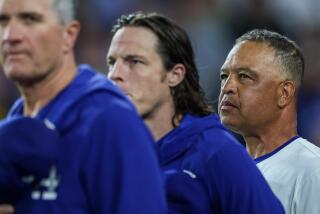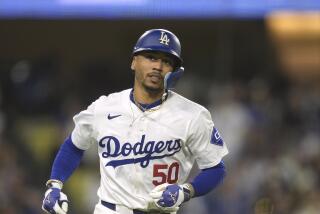BASEBALL / ROSS NEWHAN : Dodgers’ First Half Helps Gloss Over Strike Talk
In between the faxes and conference calls and other ways the owners follow the apparent meltdown to a strike, Peter O’Malley looks at the National League West standings and feels good about the future.
“I think it’s very bright,” the Dodger owner said of his club’s future, if not baseball’s.
First in the West Division at the All-Star break, the Dodgers can’t be sure how long the race will last or if the playoffs will be wiped out by the latest labor problems, but O’Malley’s optimism is based on the team’s nucleus as much as on victories, defeats or the 1994 situation.
“The possibility of an interruption is not pleasant, regardless of where we are in the standings, but I think everyone in the organization has to feel good about where the club is and how it sets up for the future,” he said.
“The farm system is producing again. The flow of talent is there again. We may have a third consecutive rookie of the year (in Raul Mondesi), and no club has ever done that (actually the Dodgers had four consecutive rookies of the year from 1979-82). We have two outstanding young pitchers in the minors (Chan Ho Park and Darren Dreifort).”
Dreifort, now with double-A San Antonio, is sidelined because of a sore shoulder. Some believe that he, as a first year pro, was used inconsistently and indiscriminately as a relief pitcher whose role was not clearly defined (see closer Todd Worrell’s recent complaints regarding his string of two-inning assignments). Some also believe Dreifort’s current problem, which the Dodgers do not consider serious, was inevitable because of that pattern, a potentially costly leak in the redeveloped flow that includes a stockpile of promising young outfielders in triple A and more home-grown players on the major league roster than any club in either league.
The flow was interrupted for much of the ‘80s because of bad draft picks and the pressure of inconsistent opportunities for several young players who eventually were successful elsewhere. Now the composition might be more impressive than the competition. The Atlanta Braves moved East, and the San Francisco Giants have faltered. The Dodgers lead a four-team division with basically the same record that left them buried at last year’s All-Star break.
Can they play it out? Will there be baseball in October?
The answers seem as uncertain as O’Malley’s position in the festering labor dispute.
Publicly, he supports the Player Relations Committee’s salary-cap proposal. Privately, however, he is linked to a big-market coalition that could live with the status quo and opposes a long work stoppage.
“Everyone loses, particularly the fans,” he said of a strike. “I’m optimistic. I think there’s enough time to avoid it.
“I don’t think there’s a crisis environment yet. I mean, there’s a lot of positioning on both sides. Don’t be misled by the rhetoric.”
Recent rhetoric has included statements by Chicago White Sox owner Jerry Reinsdorf that surprised O’Malley. Reinsdorf said a strike has the potential to wipe out the 1995 season and extend into 1996, so determined are the owners to impose a salary cap and the players to avoid it.
So far, there have been no substantive negotiations. A crisis atmosphere seems inevitable.
The union flatly opposes a salary cap and has been unable to get answers, it insists, to the most basic questions pertaining to it.
Said Don Fehr, the union’s executive director: “We’re doomed to play out the scenario.”
Fearing the owners will declare an impasse and unilaterally impose their salary cap if there is no agreement by the end of the World Series, the union contends its only leverage is to strike at some point in August or September, threatening the owners’ postseason TV revenue.
The union believes that the owners want a strike, which would make the players appear as bad guys and might challenge the solidarity that has held together through seven previous work stoppages.
The union’s executive board will meet in Pittsburgh on Monday, but a strike date is not expected to be set until after the union makes its own proposals--designed only to make minor changes in the status quo--late this week.
The owners wasted 18 months before making their salary-cap proposal. The union knew what was coming. Why has it waited so long before offering its own proposals?
“They’re the ones talking about how much the world has to change,” Fehr said.
THE RACES
It is a portrait in mediocrity, but the new division alignment and playoff format have given the owners what they wanted, even though it is in jeopardy. Using a 10-game deficit as the cutoff, 21 of the 28 teams reach the All-Star break with a shot at a division title or wild-card playoff berth.
The owners receive an estimated 75% of their TV revenue from postseason play, but Reinsdorf was quoted in the Chicago Sun-Times as saying that the scenario he fears most is a strike that erases only the crucial games of September. He estimates that the White Sox would lose $10 million in potential revenue.
“I would vote for almost any reasonable settlement,” he said. “But I can’t live with a half strike. By that, I mean a strike of a month, after which we come back for the postseason.”
In other words, if the players go out, he would rather they stay out?
Reinsdorf didn’t say, but his thinking seems to be: If they go out, they should be allowed back only wearing the salary cap.
HOPELESS HALOS
Before Buck Rodgers was so rudely interrupted by the Angels, he was saying how difficult it was to put together a rotation of pitchers who had been released by other clubs.
Honesty proved to be a bad policy for Rodgers, whose public comments were a factor in his firing. But has anyone since noticed that General Manager Bill Bavasi and staff obviously agree with Rodgers?
One released pitcher, John Farrell, has been re-released; a second, John Dopson, has been put on the disabled list; and two others, Joe Magrane and Mark Leiter, have been demoted to the bullpen.
Meanwhile, there has still been no explanation or justification for Rodgers’ firing. And don’t look for one in the midseason standings. The Angels are 20-27 under Marcel Lachemann after having gone 16-23 under Rodgers. Same basic team. Same basic results.
All the firing did was camouflage ownership’s refusal to pay for another proven hitter in the middle of their basically young lineup and Bavasi’s inability to deal.
The firing also took Plan A with it, which was to play Eduardo Perez at first base and Damion Easley at third. Now, J.T. Snow is again hitting .190 at first base and Spike Owen is risking life and limb at third while Perez--who has gone from third base to left field to first base to third base again--prepares to risk his fragile elbow there.
The Angels current plan? 1--Pursue the salary cap. 2--Build from within. 3--Check with the accountants.
have won 16 of his 18 starts this year.
* ROYAL PAIN: The noose may be tightening for Hal McRae as the Kansas City Royals experience another disappointing season in his third full year. In response to boos from the home crowd when he changed pitchers Tuesday night, McRae said:
“It’s ridiculous. They can boo me if they want, but if they’re booing the strategy, they are the dumbest fans in the world.”
With the Royals heading for a third consecutive season under 2 million in attendance, General Manager Herk Robinson swallowed hard and said, “You can’t condone Hal’s remarks. They were inappropriate. I think he’s remorseful, but that doesn’t give him the right to be critical of our fans. We have good fans. We need our fans.”
* JUICED: The strike zone is smaller and the pitching clearly thinner, but evidence also continues to point toward a livelier ball. With every team having played 80 games, one shy of half a season, major league home runs were up 416 compared with last year and runs were up 848, including a staggering 677 in the punch-drunk American League.
The average batting average in the AL was .274, compared to .265 last year, and the NL was up only from .265 to .266. The attack has taken an obvious toll on earned-run averages. They are up in the AL from 4.29 to 4.87, and in the NL from 4.05 to 4.23.
HALFWAY HONORS
One man’s midseason awards:
MOST VALUABLE PLAYER
AMERICAN LEAGUE: 1--Frank Thomas, Chicago White Sox. 2--Albert Belle, Cleveland Indians. 3--Kirby Puckett, Minnesota Twins.
NATIONAL LEAGUE: 1--Jeff Bagwell, Houston Astros. 2--Mike Piazza, Dodgers. 3--Marquis Grissom, Montreal Expos.
CY YOUNG
AL: 1--Jimmy Key, New York Yankees. 2--David Cone, Kansas City Royals. 3--Mike Mussina, Baltimore Orioles.
NL: 1--Greg Maddux, Atlanta Braves. 2--Danny Jackson, Philadelphia Phillies. 3--Ken Hill, Expos.
ROOKIE
AL: Manny Ramirez, Indians.
NL: Raul Mondesi, Dodgers.
MANAGER
AL: Mike Hargrove, Indians.
NL: Felipe Alou, Expos.
NO-WIN SITUATION
With fans electing the starters and every team required to have a representative, All-Star managers remain in an untenable position, unable to take every deserving player or avoid controversy.
“They keep adding teams, but the rosters remain at 28,” American League Manager Cito Gaston said.
He wants to expand the rosters, whether every player gets in the game or not, he said, suggesting it is enough of an honor merely being there.
Gaston was criticized last year when he selected four of his Toronto Blue Jays in addition to three who were elected as starters. He has been criticized again this year for selecting Paul Molitor and Pat Hentgen from his last-place Blue Jays, in addition to starters Roberto Alomar and Joe Carter.
Gaston acknowledged that the snubbed Jose Canseco and Julio Franco are as deserving as Molitor, who will be limited to pinch-hitting because of a sore shoulder and the absence of a designated hitter in the National League city, but added, “Molitor, after all, is a world champion, the most valuable player in the last World Series. The point is, you could avoid most of the problems if the roster was larger.”
National League Manager Jim Fregosi, who selected pitchers Danny Jackson and Doug Jones from his Philadelphia Phillies in addition to starters Mariano Duncan and Lenny Dykstra--still recovering from an appendectomy and replaced Friday by Marquiss Grissom of the Expos--also took some heat, primarily in Cincinnati, where fans and players of the first-place Reds believed first baseman Hal Morris and second baseman Bret Boone should have been selected.
“I guess you have to win a pennant and have your manager select the team,” Morris said.
Said Cincinnati outfielder Kevin Mitchell: “They took (Pittsburgh’s) Carlos Garcia over Bret Boone? Hal Morris didn’t make it? Man, this world needs an enema.”
More to Read
Are you a true-blue fan?
Get our Dodgers Dugout newsletter for insights, news and much more.
You may occasionally receive promotional content from the Los Angeles Times.








